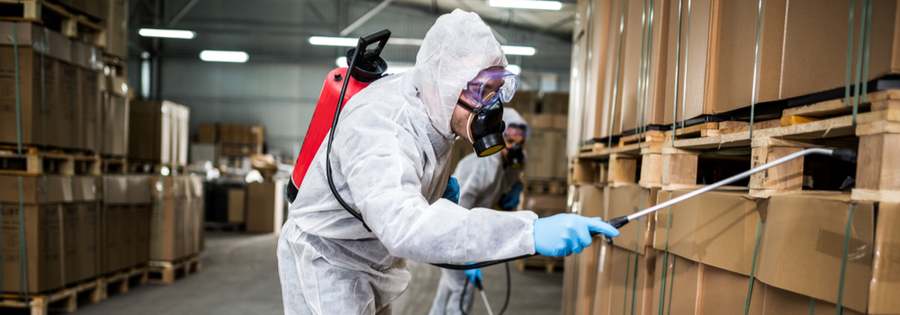Chicago Crawler Extermination Services: Safe and Reliable Removal
Chicago Crawler Extermination Services: Safe and Reliable Removal
Blog Article
A Comprehensive Overview to the Different Sorts Of Pest Control Approaches
With the myriad of bug control methods available, it can be overwhelming to find the most efficient option for a certain bug issue. In this thorough overview, we will discover these different types of insect control techniques, supplying insights right into their applications and benefits. By the end, you will have a clearer understanding of which method might be the best fit for your bug control needs.
Chemical Pest Control Techniques

One typical type of chemical bug control is insecticides. Pesticides target specific insects, such as insects, termites, or ants, and can be made use of both inside and outdoors.
An additional kind of chemical insect control is rodenticides. These are chemical substances developed to regulate populations of rodents, such as rats and computer mice. Rodenticides are generally utilized in bait form, which brings in the rodents and afterwards kills them after intake. They are typically made use of in agricultural setups, in addition to in household and business structures (Customized pest control solutions Chicago).
Herbicide, also recognized as herbicides, are another kind of chemical bug control approach. Herbicides are made to uniquely kill undesirable plants, recognized as weeds, without causing damage to preferable plants. They are commonly made use of in farming, landscaping, and gardening to control the growth of unwanted greenery.
While chemical insect control methods can be extremely effective in eliminating parasites, it is important to utilize them carefully and adhere to security guidelines. Overuse or abuse of chemical pesticides can have adverse effect on human health and the environment. For that reason, it is essential to employ these approaches responsibly and think about different pest control methods whenever feasible.
Biological Bug Control Methods
Organic pest control methods involve making use of living microorganisms or all-natural materials to take care of and control pest populaces. Unlike chemical methods, which typically depend on synthetic pesticides, organic control approaches utilize the natural enemies of pests to manage their populaces. This method is taken into consideration even more eco-friendly and sustainable, as it decreases the usage of hazardous chemicals and lessens the threat of pesticide resistance.
One commonly utilized organic parasite control method is the introduction of all-natural predators or parasites. As an example, ladybugs are presented to control aphids, while certain wasp species are launched to target caterpillars. These predators and parasites eat bugs, lowering their numbers and avoiding invasions.
One more organic control approach is the usage of virus. Particular microorganisms, infections, and fungis can be used to contaminate and eliminate specific bugs. The germs Bacillus thuringiensis is typically used to manage caterpillars, as it creates contaminants that are dangerous to these bugs.
Biological control techniques can additionally entail the usage of pheromones or all-natural compounds that interfere with the mating patterns of parasites. By disrupting their reproduction, these techniques help to reduce pest populations gradually.
While organic insect control approaches are normally reliable, they may call for longer periods to accomplish wanted results contrasted to chemical methods. Furthermore, mindful consideration has to be provided to the selection and launch of natural adversaries to stop unintentional damage to advantageous organisms or ecosystems.
Physical Pest Control Methods
To properly handle and control pest populaces, alternative insect control methods recognized as physical pest control techniques are employed. An additional physical insect control approach is the setup of fencings click for more or wall surfaces to maintain larger pests, such as deer or bunnies, out of yards or agricultural areas. Physical bug control approaches are an environmentally pleasant choice to chemical pesticides, as they do not depend on the use of damaging chemicals.
Natural Bug Control Approaches
All-natural parasite control techniques provide a lasting and environmentally friendly method to handling and eliminating insects. These methods prioritize using natural substances and organic agents, lessening the need for chemical pesticides that can harm the environment and human health. One of the most typical natural bug control techniques is organic control. This entails presenting natural killers or parasites to prey on or parasitize the parasites. Ladybugs are often introduced to yards to control aphid populaces. One more natural technique is making use of repellents stemmed mouse prevention from plants. Specific plants, such as marigolds, lavender, and pepper mint, send out aromas that ward off insects like insects, flies, and ants. In addition, social control techniques can be utilized to stop and take care of insect problems. This consists of appropriate cleanliness, normal upkeep, and advertising biodiversity in the garden. For example, revolving plants, getting rid of garden debris, and motivating all-natural killers can assist prevent the accumulation of pests. By taking on these all-natural parasite control techniques, individuals and neighborhoods can efficiently manage insects while decreasing the adverse effect on the atmosphere and human health.
Integrated Bug Management (IPM)
Integrated Pest Administration (IPM) is a thorough and systematic strategy to pest control that incorporates different approaches and strategies to efficiently handle bugs while decreasing using chemical pesticides. IPM intends to maintain parasite populaces below the economic injury degree by making use of a combination of social, organic, and chemical control approaches.
Cultural control techniques involve changing the atmosphere to make it less desirable for bugs. This can include techniques such as crop turning, proper sanitation, and using resistant plant selections. By developing undesirable conditions browse around here for parasites, social control approaches can significantly decrease pest populaces.

Chemical control techniques are made use of as a last option in IPM. They include the targeted and sensible usage of chemicals to handle insect populations. Unlike standard bug control techniques, IPM aims to minimize making use of chemical pesticides by utilizing alternative methods.
Integrated Pest Management (IPM) is an aggressive strategy that concentrates on lasting pest administration instead than depending solely on reactive steps. By integrating multiple control techniques, IPM provides an extra lasting and environmentally friendly method to pest control.
Final Thought
It reviewed chemical, biological, physical, and natural insect control techniques, as well as the integrated insect monitoring method. By understanding these various approaches, people can make enlightened choices on which bug control approach is most ideal for their particular requirements and preferences.
Report this page